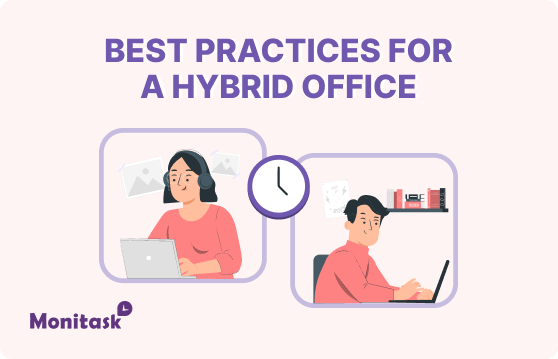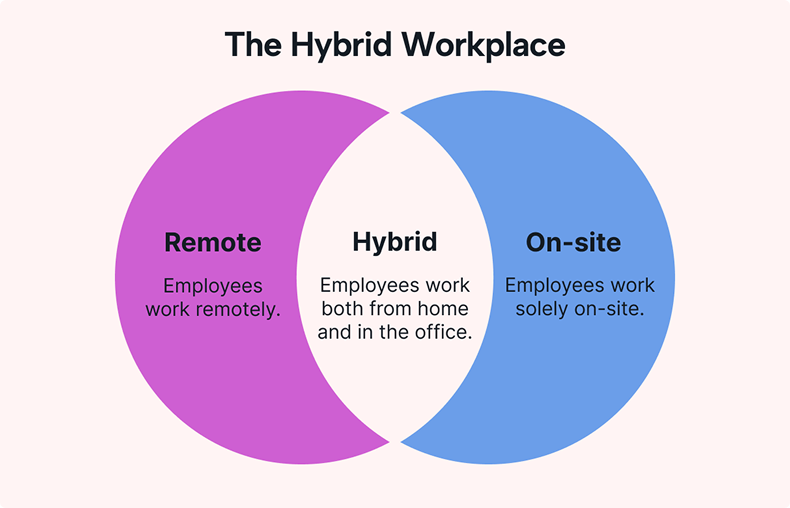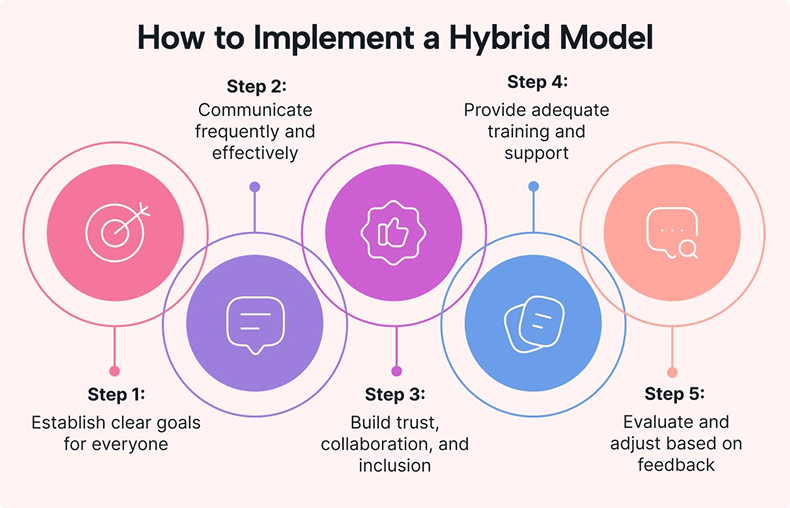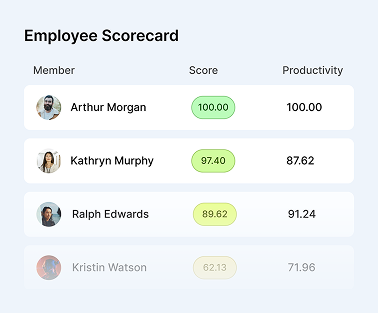Best Practices for a Hybrid Office

Hybrid work isn’t just a trend — it’s the new operating system for modern business. Over 70% of companies now use some form of hybrid model, but many still struggle with uneven communication, burnout, and a “two-tier” culture between in-office and remote employees.
The difference between thriving and barely getting by? Having the right systems, habits, and mindset in place.
Here’s how to build a hybrid office that keeps your team aligned, engaged, and performing at their best — wherever they work.

How to Build a Productive, Inclusive, and Flexible Work Environment
Hybrid work isn’t just about splitting time between home and the office — it’s about rethinking how, when, and where work happens.
Without the right structures, it can quickly slip into confusion, burnout, or an “us vs. them” divide between remote and in-office employees.
The following best practices will help you design a hybrid workplace that’s clear, connected, and genuinely supportive of everyone on the team.
1. Set Clear Hybrid Work Policies
A successful hybrid workplace starts with clear, detailed policies.
Define how many in-office days are expected, which roles qualify for remote work, and standard working hours or core availability.
Specify communication protocols — from quick chats to formal updates — and set meeting guidelines, whether remote-first, hybrid, or in-person only when necessary.
Involve leaders and employees in shaping these rules, and review them regularly to adapt to changing needs.
The goal is to balance flexibility with accountability, giving employees the clarity and structure they need to plan their weeks, stay aligned, and deliver their best work anywhere.
2. Emphasize Outcome-Based Performance
In hybrid work, productivity isn’t about hours spent at a desk — it’s about results.
Shift the focus from presence to measurable outcomes by setting clear goals and deliverables for every role.
Success should be defined in terms of project progress, work quality, and contributions to team objectives.
Managers must lead with trust, avoid micromanagement, and give regular, constructive feedback. They should also guard against proximity bias, ensuring remote employees are valued equally to in-office colleagues.
Guiding questions include:
- What does success look like for this role?
- Are goals realistic and aligned with priorities?
- Does the employee understand their impact?
- Are we rewarding effort, output, or both?
When performance is measured by impact, employees gain autonomy, engagement rises, and the conversation shifts from where people work to what they accomplish — creating a culture of accountability and shared results across locations.
3. Invest in the Right Technology
A hybrid office thrives on a solid digital foundation. Go beyond email and video calls by building a tech stack that supports both real-time and asynchronous work. This includes reliable video conferencing, cloud-based document sharing, and project management tools for task visibility.
Add messaging apps for quick chats and structured updates, plus strong security measures like VPNs, two-factor authentication, and password managers.
Ensure equal access to IT support and consider providing or reimbursing home office equipment.
The right tools create equity, streamline collaboration, and fade into the background — making hybrid work seamless, secure, and productive for everyone.
4. Make the Office a Magnet, Not a Mandate
In hybrid work, the office should be a destination, not an obligation. Employees are more likely to show up when in-office time offers real value — meaningful collaboration, team connection, or a refreshing change of scenery.
This means creating comfortable, flexible spaces for both deep focus and casual interaction, not just providing desks and Wi-Fi. Leaders can boost attendance by aligning office days with activities best done face-to-face, like brainstorming, planning, or creative sprints.
When people see the office as a place that enhances their work and relationships, they’ll choose to be there — no mandate required.

5. Prioritize Asynchronous Communication
Hybrid teams work best when communication isn’t bound to the clock. Asynchronous communication lets people contribute on their own schedule, accommodating time zones, deep work, and personal flexibility.
It promotes clarity, documentation, and focus while reducing meeting overload. Use tools like emails, shared docs, project boards, or recorded updates to keep work moving without requiring simultaneous availability.
Leaders can model this by sharing written updates instead of defaulting to meetings and by answering questions in shared spaces.
Making async the norm minimizes burnout, improves inclusion, and builds a culture where communication is thoughtful, transparent, and free from constant interruptions.
6. Be Intentional About Inclusion
Hybrid work can unintentionally favor in-office staff over remote employees. Prevent this by building inclusion into your processes and communication. Key practices include:
- Run meetings “remote-first” so everyone joins on equal terms.
- Rotate facilitation roles to give all team members leadership visibility.
- Celebrate wins across locations using Slack shout-outs, virtual town halls, or newsletters.
- Ensure equal access to career development and mentorship, regardless of location.
Inclusion in a hybrid world is about equal access to opportunity, information, and connection — and it only happens through conscious design.
7. Schedule “Anchor Days” for Collaboration
Anchor days are pre-planned in-office days focused on purposeful collaboration — such as planning sessions, creative work, sprint reviews, or team bonding — rather than simply filling seats.
By aligning these days with shared goals, you remove the uncertainty of who will be in and ensure in-person time is meaningful.
They also help strengthen team culture through casual interactions like hallway chats, lunch outings, and impromptu brainstorms.
A couple of well-timed anchor days each month often delivers more value than rigid attendance rules, striking the right balance between flexibility and connection in a hybrid workplace.
8. Provide Stipends for Home Office Equipment
A comfortable, well-equipped workspace directly impacts productivity and well-being. Show commitment to hybrid flexibility by offering stipends for home office upgrades — from ergonomic chairs and standing desks to extra monitors or better lighting.
This support not only boosts output but also promotes inclusion, ensuring all employees have access to quality setups regardless of personal budgets.
Even a one-time stipend of $500–$1,000 or a small monthly allowance can level the playing field, improve comfort, and help employees work effectively from anywhere.
Investing in home offices is investing in your team’s long-term success.
Maximize productivity of your business
Track employee productivity and simplify work with them
9. Train Managers for Hybrid Leadership
Great in-office managers don’t automatically excel in hybrid settings — leading distributed teams requires new skills.
Companies should train managers to avoid proximity bias, build trust, and support employees equally across locations.
Modern hybrid leadership focuses on trust, clear communication, empathy, and outcome-based management. Core competencies include:
- Leading with trust instead of control
- Communicating consistently across locations
- Using tools for visibility without surveillance
- Giving feedback regularly and with context
- Encouraging connection and team belonging remotely
By developing these skills, managers become culture carriers who drive engagement, inclusion, and performance in hybrid teams.

10. Continuously Gather Feedback and Iterate
Hybrid work is an ongoing experiment, not a one-time setup. Use surveys, anonymous polls, open office hours, or monthly check-ins to uncover what’s working and where gaps exist.
Ask about flexibility, meeting inclusivity, and whether anyone feels left out. Feedback matters only if acted on — share what you’ve heard, the changes you’ll make, and why.
This builds trust and reinforces that hybrid success comes from listening, adapting, and improving together, not enforcing rigid rules.
Conclusion: Hybrid Work Is Here to Stay
The hybrid office isn’t a temporary trend — it’s the new norm. Companies that invest in thoughtful hybrid strategies will not only boost productivity and engagement but also retain top talent who value flexibility.
By setting clear expectations, embracing digital tools, designing inclusive experiences, and staying adaptable, you’ll create a hybrid workplace where everyone can thrive — whether they’re logging in from the office or their living room.
And remember: The future of work isn’t about where we are — it’s about what we can achieve together!
– The Monitask Team
FAQ: Hybrid Office
How can we avoid proximity bias in hybrid teams?
Proximity bias happens when in-office employees receive more attention or recognition simply because they’re physically present. To avoid this, leaders should adopt remote-first habits: run meetings on video even for in-office teams, track performance by outcomes (not presence), and ensure recognition and feedback are distributed fairly across all team members.
What tools are essential for successful hybrid collaboration?
At a minimum, you’ll want:
A reliable video conferencing platform (Zoom, Google Meet, etc.)
Cloud-based document collaboration (Google Workspace, Microsoft 365)
Project/task management tools (Asana, Trello, Notion)
Messaging apps (Slack, Microsoft Teams)
Secure VPN or SSO access for remote work
Time tracking and productivity management tools like Monitask to help teams stay on track, monitor workloads, and ensure transparency without micromanaging.
Bonus points for asynchronous tools like Loom or company wikis to reduce meeting overload.
How do we keep company culture strong with hybrid teams?
Culture doesn’t vanish in hybrid work — but it needs intentional care. Encourage regular team check-ins, celebrate wins publicly, and make space for casual social interactions online (like virtual coffee chats or game hours). Also, invest in periodic in-person team retreats or events to keep people connected.



